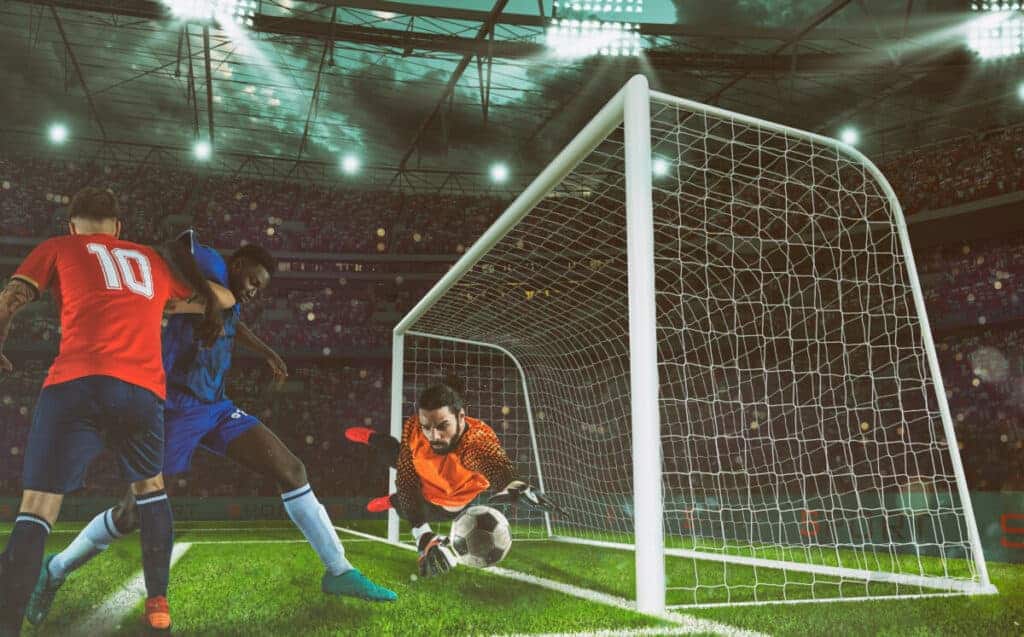can you use your forearm in soccer
Probably the number rule in soccer is that you can’t use your hands. Because of this, many people have questions about the specifics of the rules, what you can use your hands or arms for, what parts of the arms are allowed and when, and so on. If you’re curious about using the forearm in soccer, you’ve come to the right place.

Using a forearm to push or pull another player in any direction in soccer is against the rules. The forearm should only be used to create distance between another player and the ball or to block them from stealing the ball, but once blunt or excessive force is used, the player will be penalized.
You may be surprised to learn what is and isn’t acceptable when it comes to using your arms in soccer, so continue reading to learn more!
Using your forearm in soccer to block
When you have possession of the ball and an opponent approaches to attempt to steal the ball, you can use your forearm to block them. This does not mean pushing the opponent away with your forearm nor does it mean applying pressure against the opponent for a long period of time or using any sort of excessive force with your forearm. Instead, you can raise your extended and bent arm and use your forearm to create a barrier between the ball and the opponent as a defense.

You should constantly be moving during this move and only use it for tactical reasons to defend the ball, dribbling, and using your feet to manipulate the ball away from the opponent as you defend it. You can also lean back while defending the ball to create more distance and make it more difficult for the opponent to get a hold of the ball, turning directions to protect the ball.
The moment you use your forearm to push against another player or use it with excessive force, you’ll be penalized by the referee, manager, or match official either by being issued a yellow or red card, giving the opposing team a penalty kick, or even being removed from the game.
Here is a visual demonstration for how you can use your forearm to block an opponent during a soccer game:
When you can’t use your forearm in soccer
If you use your forearm, whether it’s to defend the ball, to get past other players, to push another player away, or to attack another player for any reason, with excessive force or with the intent to harm another person, you’ll be penalized. The severity of that penalty will vary and be determined by the match official or referee.
You also should avoid using your forearm to block opponents in any situation other than when you are actively in possession of the ball (dribbling or manipulating the ball with your feet) and only for the purpose of shielding the ball.
Any sort of force that impedes another opponent such as moving into their path to obstruct, force change, block, or slow down that opponent when the ball is not within kicking distance is against the rules.
If you extend your arms, but your forearm is still the only part of your arm that is in contact with the opponent, it can still be considered a foul. When shielding the ball and blocking an opponent, keep your arm bent and low to avoid getting called out of the game.
Rules for using your hands and arms in soccer
It’s a general rule of thumb that you don’t use your arms, from the tops of your shoulders to the tips of your fingers, to intentionally touch the ball, unless you are a goalie. This includes your forearms. You also should not use your hands or arms to pull, push, or hit another player in an offensive or defensive manner.

As mentioned earlier, you can only use the forearm to block another player or use an extended and bent arm to create distance between another player and the ball while you’re handling the ball with your feet. Using any excessive force to push another player in one direction or another is considered a foul, regardless of which part of your arm you use. Don’t stick your arm straight out to push an opponent or another player away from you or the ball. This is also considered a foul.
You also cannot use your arms or hands to grab or pull another player. This includes grabbing their clothes to pull at them and manipulate their direction, as well as using the whole arm to pull down the player by the legs, head, or torso. This is another action in the game that is considered a foul which is judged and penalized by the referee or match official.
If a ball is coming towards you, you should not use your hands or arms to protect your face, as this can be penalized by the referee. Instead, you can dodge the ball another way by ducking or moving away.
When you can use your arms during gameplay
There are some instances when using the arms is permitted during the game, so long as they don’t intentionally come in contact with the ball or other players. The first thing you can use your arms for is to shield the ball by blocking another player from getting close to the ball. This is done by using the forearm in a bent and low position.
Remember, there is a difference between blocking and pushing. If the other player is coming toward you with the intent to steal the ball while you’re dribbling it, you can put your forearm out against their chest to keep them from moving forward, but not in a way to push them back. You should not grab or pull the other player toward the ground or in any direction while blocking to get them away from the ball, or use any other part of your arm to block the other person.
If the ball is kicked toward you and hits your arm or hand, this is not considered a handball, as handballs are only considered to be intentional contact between the ball and the player’s hands or arms.
You can also use your arms in non-defensive ways, such as to communicate with other players that you’re ready for the ball to be passed to you, to help you keep your balance during the gameplay, to jump higher (be aware of your surroundings to ensure you won’t hit/hurt anyone with your arms or elbows as you jump), or to run faster.
If you’re a goalie, the rules for using your arms are a bit different. As a goalie, you can use your arms inside your 18-yard box as you’re defending the goal, and your hands and arms can come in contact with the ball when playing this position to keep the opposing team from scoring a goal.
